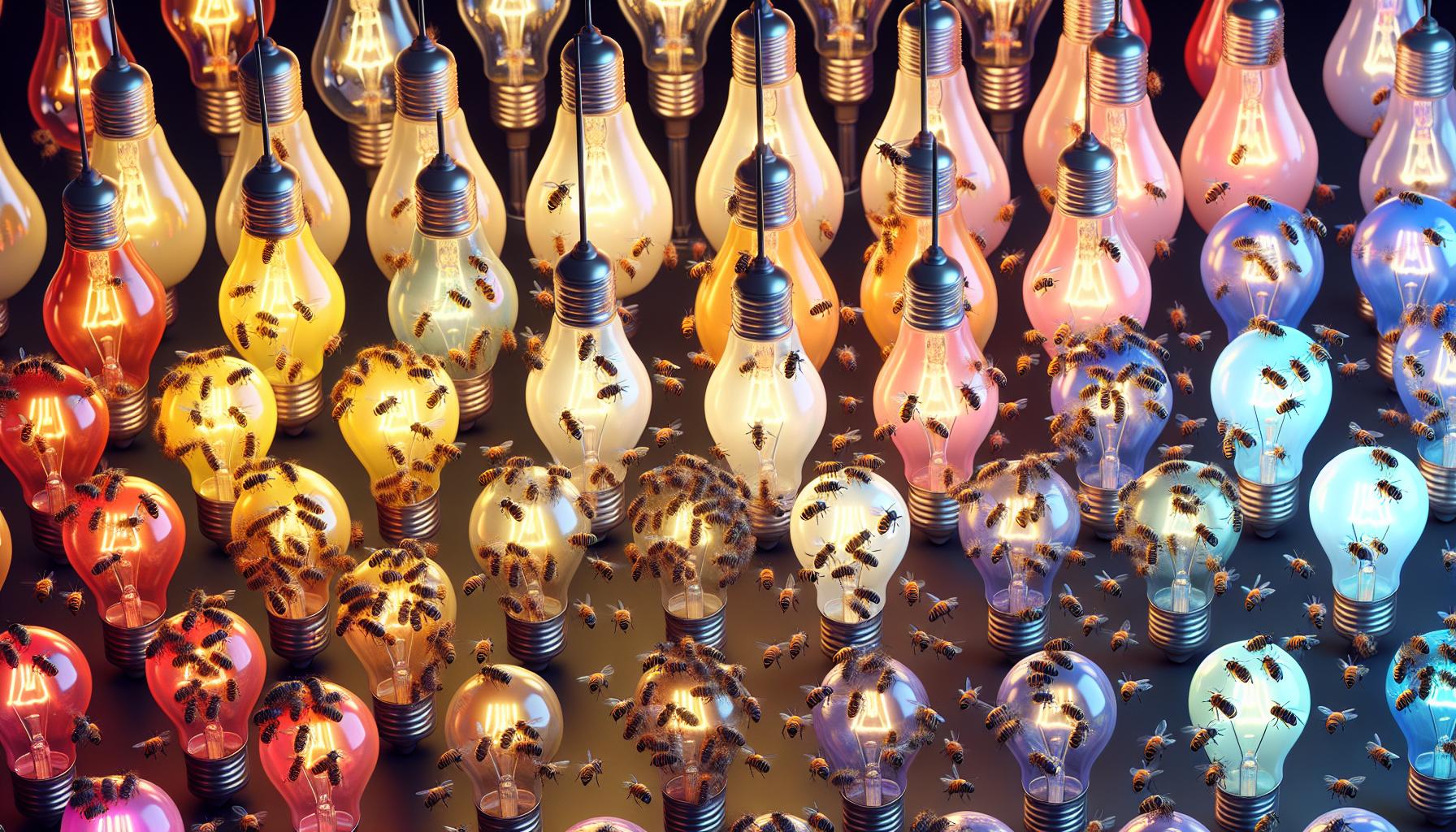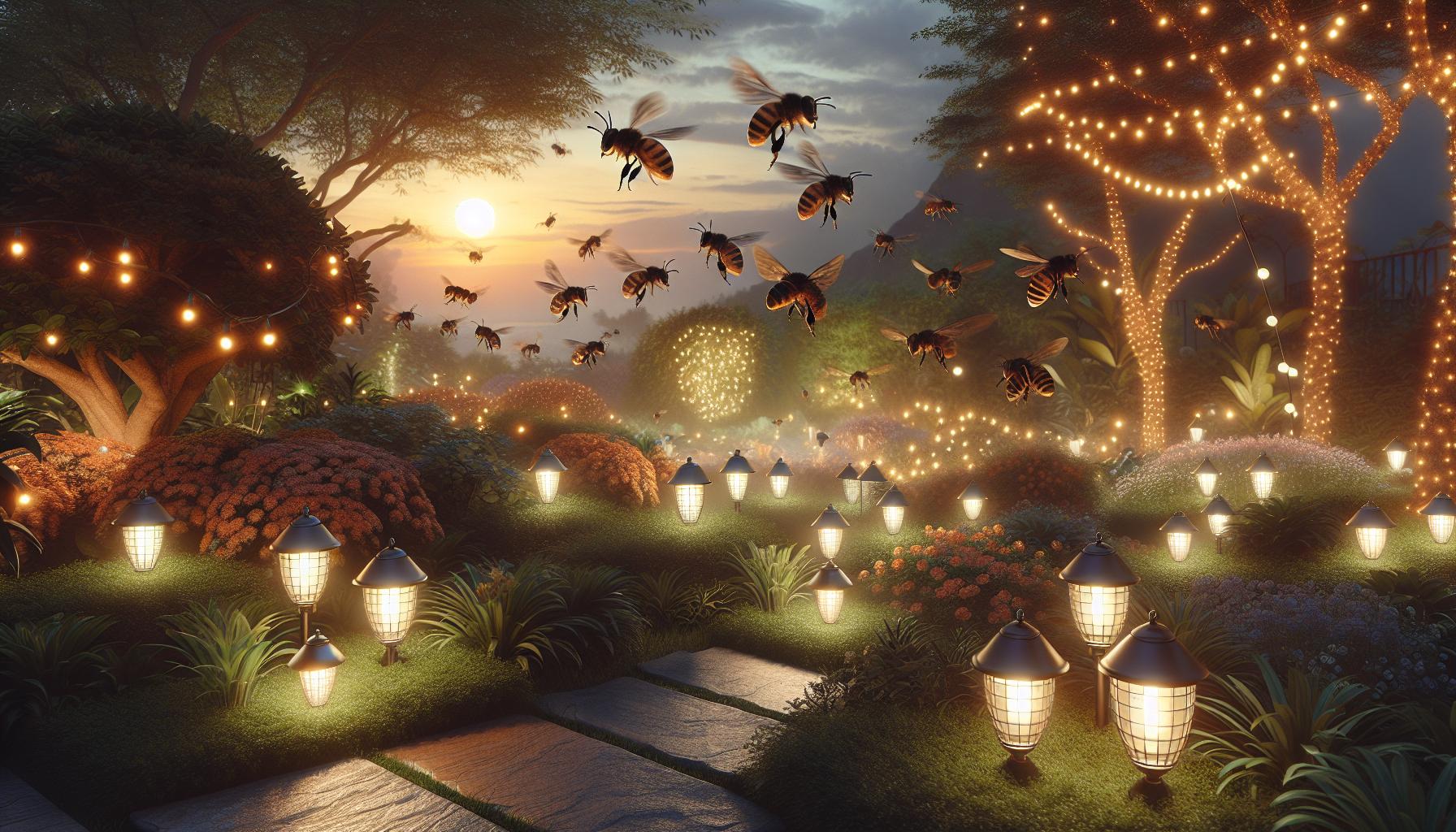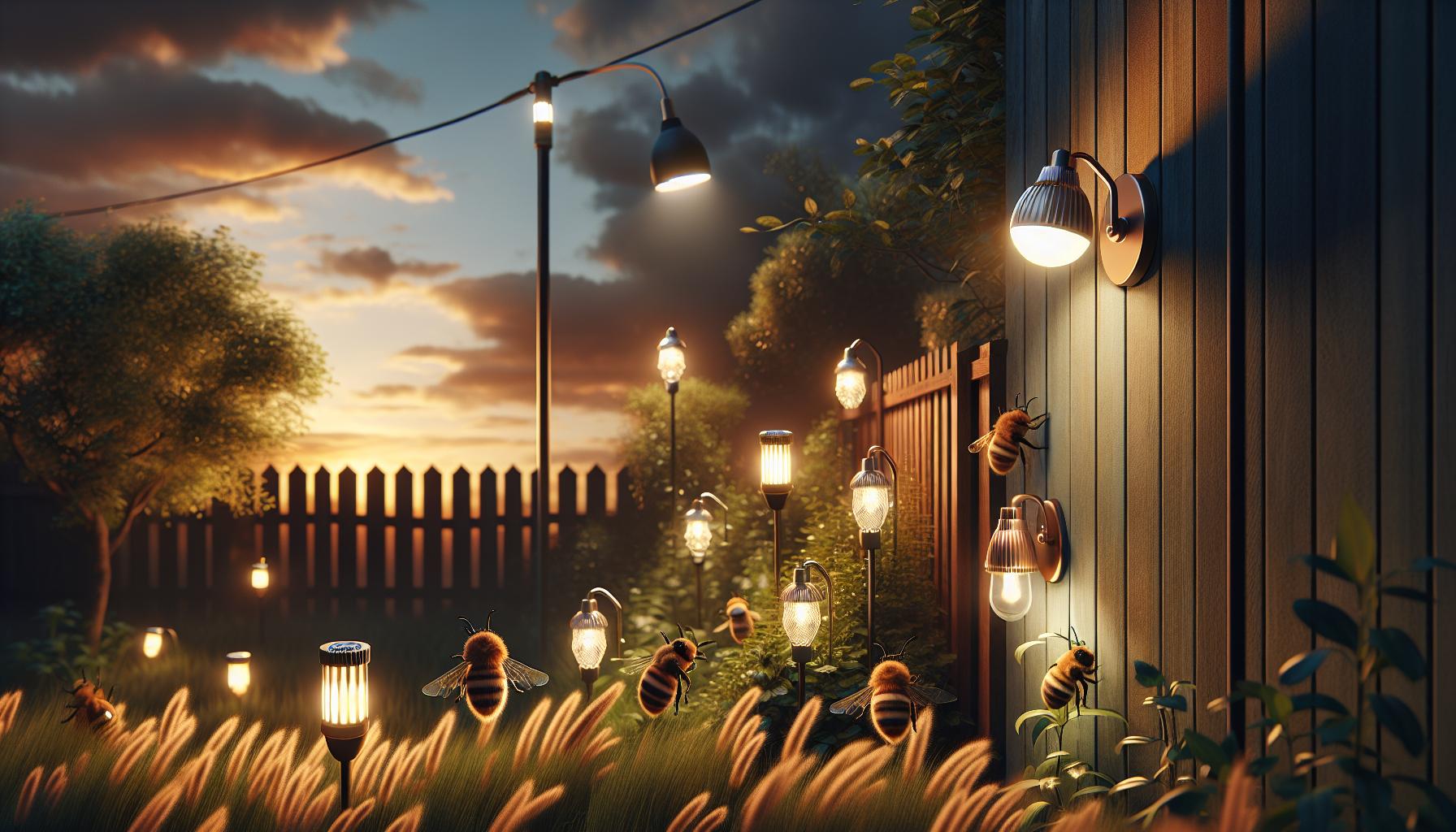Ever found yourself wondering if those buzzing bees are drawn to your porch light like moths to a flame? It’s not just your imagination. Bees and light bulbs have a bit of a complicated relationship, and it’s one that’s fascinating to unravel.
While you’re enjoying a warm summer evening, you might notice more than just fireflies flitting around your garden lights. Bees seem to be in on the action too. But what’s really going on here? Do bees actually like light bulbs, or is there more to this nighttime dance?
In the buzz of night, the way bees interact with artificial lights can tell us a lot about their behavior. Let’s dive into the glowing world of bees and bulbs to uncover the truth behind their luminous attraction.
The Relationship Between Bees and Light Bulbs
Ever noticed how bees buzz around your porch light? You might wonder if they’re mistaking it for the sun. Bees are normally diurnal, preferring daylight, but some light bulbs emit wavelengths that mimic the sun’s rays, potentially misleading bees after dusk.
Your outdoor lighting choices could be influencing local bee traffic. LED and CFL bulbs often have a broad spectrum of light, which includes ultraviolet (UV) rays. Most bees have UV vision capabilities, allowing them to see patterns on flowers that direct them to the nectar. The same UV rays in artificial lighting could be drawing bees in, thinking they’ll find food.
- Incandescent bulbs may be less attractive as they emit warmer tones with fewer UV rays.
- Halogen options are somewhat similar to natural sunlight but more intense, possibly confusing bees more than incandescent options.
It’s a delightful DIY project to switch out bulbs and observe the changes in your backyard ecosystem. Plus, an understanding of bees’ attraction to light can help you plan your garden lighting better to support local pollinators or deter them if necessary.
In urban areas with dense human populations and artificial lights, bees’ nocturnal activity might be increasing. This shift in behavior could be due to light pollution altering their internal clocks, leading to changes in the time they visit flowers.
Monitoring bee activity around different bulb types is a handy method to learn about their preferences. Consider documenting the frequency of bees around various bulbs in your garden and experimenting with different lighting designs to balance aesthetic needs with ecological consideration.
Remember that while switching up your light sources can be an engaging activity, it’s equally important to ponder the long-term effects. Reducing light pollution not only benefits our star-gazing experiences but likely has a positive impact on our buzzing friends. After all, a well-lit home that coexists with nature could be the brightest idea yet.
Why Bees are Attracted to Light Bulbs
Ever wondered why your evening garden buzzes with more than just the chatter of friends? Like moths to a flame, bees are often drawn to the artificial suns in our backyards: light bulbs. But, it’s not just any light bulb that gets their wings in a flutter. It’s the ones that send out specific signals, ones that mimic the cues of nature they’re hardwired to follow.
Think about UV light, for instance. Bees have vision superpowers that allow them to see ultraviolet patterns on flowers, which are invisible to the human eye. These patterns act like landing strips, guiding them to the nectar. Traditional incandescent bulbs don’t emit this type of light, but many modern bulbs, like compact fluorescents and LEDs, can. They emit a wider spectrum of light, including UV, which can inadvertently act as a beacon for bees.
The warmth of a bulb also plays a part. On a cool evening, light bulbs become miniature suns, offering pockets of warmth. Bees, being cold-blooded, might seek these spots to regulate their body temperature.
Now you might think, ‘But I’ve got LED bulbs, they don’t get that hot!’ Right, but LEDs can still emit a glow that grabs a bee’s attention, just less of that cosy warmth. Plus, with the push towards energy efficiency, more and more gardens are glowing with LED and fluorescent lights, greatly expanding the bees’ nightly hangouts.
« Is It OK to Touch LED Light Bulbs? Find Out the Surprising Truth
Why Light Bulbs Get Hot: Discover the Surprising Truth Behind the Glow »
Remember that bees’ attraction to light varies according to the type and color of the light emitted. Here’s a quick list of bulb types and their allure to bees:
- Incandescent bulbs: Minimal UV light, less attractive to bees
- Compact fluorescents (CFLs): Moderate UV light, somewhat attractive
- LEDs: Varying UV emission depending on the type, can be highly attractive
What does this mean for your DIY garden lighting project? It’s a balancing act between energy efficiency and pollinator support. Consider the type of light you’re installing and its potential impact on your buzzing garden visitors. And if you’re eager to minimize your contribution to light pollution and keep the bees’ natural rhythms intact, thinking about the type and placement of outdoor lighting is a smart start.
The Science Behind Bees’ Behavior with Light Bulbs
As someone deeply fascinated with the nuances of lighting, you likely understand that not all light bulbs are created equal, especially when considering their effects on our flying friends, the bees. But what exactly is the science behind this phenomenon? Let’s illuminate the facts.
Bees have complex vision that allows them to see ultraviolet light, a spectrum invisible to humans. This ability enables bees to find flowers and navigate, as many plants reflect UV light to attract pollinators. When it comes to artificial lighting, bees can get confused. Light bulbs that emit UV light, similar to the sun’s rays, have a powerful allure for these creatures.
Furthermore, the type of bulb can exacerbate this attraction:
- LED lights: Although they are energy-efficient, some LEDs emit a spectrum of light that includes UV.
- Compact Fluorescent Lamps (CFLs): These too give off UV radiation and can attract bees, even if the emission is less intense than other bulbs.
- Halogen and Incandescent bulbs: With reduced UV emissions, these may be less enticing, though their warmth can still draw bees in colder temperatures.
It’s important to realize that while the warmth of a bulb can be a factor, it’s the UV emissions that are the prime bee attractor. Here are some factors that determine the attractiveness of a bulb to bees:
- Wavelength: Bees are most attracted to light in the UV and blue spectrum.
- Intensity: The brighter the light, the more bees it may attract.
With this knowledge, you’re now equipped to tackle those home DIY lighting projects with an eye towards being bee-friendly. Consider the implications of your lighting choices for the local ecosystem. Opting for bulbs with minimal UV output and dimmer, warmer lights where necessary could help in protecting these vital pollinators from unnatural attractions.
The Impact of Artificial Light on Bees
As a light bulb aficionado and DIY enthusiast, you’re no stranger to the allure of a well-lit space. But when you’re selecting bulbs for your outdoor lighting project, it’s important to consider your tiny winged neighbors—the bees. Artificial light, particularly at night, can have profound effects on their behavior and health.
Bee navigational patterns rely heavily on natural light sources, such as the sun and moon, for orientation. Your garden lights, though appealing to the human eye, create what’s known as light pollution. This can disorient bees and disrupt their normal nocturnal activities. They might end up expending energy flying towards the light instead of resting or returning to their hive, which can lead to exhaustion or even demise.
Studies have shown that bees’ circadian rhythms—their internal biological clocks—are susceptible to light at frequencies they can perceive, including those emitted by artificial sources. Disruption of these rhythms can hinder bees from performing vital tasks, like foraging and pollination at the correct times, ultimately affecting the ecosystem’s balance.
When you’re choosing light fixtures, you might want to look for options that minimize UV emissions. Shielding your lights so they’re less visible to bees and turning them off after a certain hour are pragmatic measures you can adopt. Additionally, motion-detection sensors can ensure lights are on only when necessary, reducing the window of potential disruption to local bee populations.
Remember, your lighting choice doesn’t just affect your evening ambiance—it plays a significant role in the lives of bees. By opting for lights that are less attractive to these essential pollinators, you craft not only a beautiful space but also a bee-friendly environment. So go ahead, tweak your lighting plans, and give a nod to the bees as you do it. They may not say thank you, but the thriving garden they pollinate will be gratitude enough.
Bee-Friendly Lighting Options
When you’re knee-deep in your latest DIY project, it’s crucial to remember our buzzing buddies outside. Bees thrive in environments that mimic natural light conditions, so choosing the right bulbs for your outdoor space can make a huge difference.
Warm-colored LED bulbs are the go-to for bee safety. They emit a softer, orange-hued light that’s less disruptive to nocturnal pollinators. These LEDs are crafted to offer minimal UV emissions, which keeps bees from flying off course. Your garden gets the glow it needs without throwing off the vital foraging patterns of local bees.
Another savvy choice is sodium vapor lights. Their amber glow has a low attraction rate for insects, making them a friendlier option for a bee-conscious homeowner. Alongside reducing the allure for bees, these fixtures are energy efficient—which means you’re not just helping your local pollinators but also your electricity bill.
For those looking to go the extra mile, consider lights with built-in motion sensors. They’ll ensure your outdoor lighting isn’t running all night, which is a major plus for both energy conservation and minimizing light pollution. With these, lights only activate when you or guests are present, drastically decreasing the amount of time your lights could impact bees.
Here’s a quick glance at bee-friendly lighting options:
- Warm-colored LED bulbs
- Sodium vapor lights
- Motion sensor-equipped lighting
Remember, it takes only a few small adjustments to your lighting choices to support a healthy ecosystem for bees. Consider the timing of your outdoor lights as well—switching them off when they’re unnecessary can do wonders. And if you’re worried about security, timer systems are a fantastic way to balance both needs.
Embrace timers, shield your bulbs to direct light downward, and opt for the right colors and technologies. Not only will you create a cozy ambiance for your evening BBQs, but you’ll support the bees that make those flowers in your garden flourish.
Conclusion
You’ve got the buzz on bee-friendly lighting now! Remember, swapping out your bright, blue-white bulbs for warm LEDs or sodium vapor lights not only helps our little pollinator friends but also reduces energy consumption. Don’t forget about adding motion sensors and timers to keep light pollution in check. With these simple changes, you’ll create a welcoming atmosphere for both bees and your evening guests. Let’s light up our outdoor spaces the right way and give bees the peaceful night’s environment they deserve.
Frequently Asked Questions
Q1: Why is it important to choose bee-friendly lighting?
Outdoor lighting can disrupt bees’ natural behaviors. Choosing bee-friendly lighting helps support a healthy ecosystem for bees.
Q2: What types of bulbs are recommended for bee-friendly lighting?
Warm-colored LED bulbs or sodium vapor lights are recommended, as they emit a soft, orange-hued light with minimal UV emissions.
Q3: How do bee-friendly lights conserve energy?
These lights are energy-efficient and can be fitted with motion sensors or timers to reduce unnecessary usage, conserving energy.
Q4: Can using bee-friendly lighting help with outdoor ambiance?
Yes, bee-friendly lighting can create a cozy and inviting ambiance in outdoor spaces while being environmentally responsible.
Q5: How do motion sensors in lighting help the bees?
Motion sensors reduce the amount of time lights are on, minimizing light pollution and lowering the impact on bees and other nocturnal wildlife.





